S-Hertogenbosch, Province of Noord-Brabant, Netherlands 作者: 来源: 发布时间:2021-02-22
一、人口,面积,所属地区
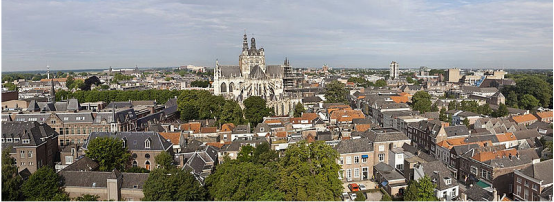
Location in North Brabant
Country Netherlands
Province Noord-Brabant
Government
• Body Municipal council
• Mayor Jack Mikkers (VVD)
Area
• Municipality 91.79 km2 (35.44 sq mi)
• Land 84.45 km2 (32.61 sq mi)
• Water 7.34 km2 (2.83 sq mi)
Elevation 6 m (20 ft)
Population (Municipality, January 2019; Urban and Metro, May 2014)
• Municipality 154,205
• Density 1,826/km2 (4,730/sq mi)
• Urban 169,714
• Metro 198,000
• Metro region 355,230
• Brabant CMSA 1,932,055
Demonym(s) Bosschenaar
Area code 073
Website s-hertogenbosch.nl
's-Hertogenbosch is a city and municipality in the Netherlands with a population of 152,968. It is the capital of the province of North Brabant.
The city of 's‑Hertogenbosch, commonly called Den Bosch, is the capital city of the province of Noord-Brabant. The city and region are attractive for entrepreneurs. Every day, entrepreneurs benefit from its bustling inner city, exuberant networking culture and unique ecosystems.
The urban and rural areas that constitute the municipality of Den Bosch is home to 153,452 inhabitants per 1 January 2018. The workforce comprises well over 77,000 people (Statistics Netherlands, 2018).
二、自然地理
Population centres
The population centres in the municipality are: Bokhoven, Crevecoeur, Deuteren (former village), Dieskant, Empel, Engelen, Gewande, 's-Hertogenbosch, Hintham, Kruisstraat, Maliskamp, Meerwijk, Orthen (former village), Oud-Empel, and Rosmalen.
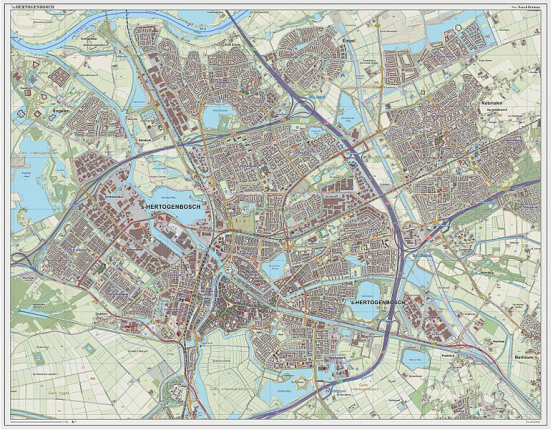
Dutch Topographic map of 's-Hertogenbosch, as of March 2014
Climate
Climate in this area has mild differences between highs and lows, and there is adequate rainfall year-round. The Köppen Climate Classification subtype for this climate is "Cfb". (Marine West Coast Climate/Oceanic climate).
Transport
The Zuid-Willemsvaart runs from the Meuse just north of the city towards Maastricht via Helmond and Weert. In 's-Hertogenbosch it runs through the city proper, south east from where a bastion has been cut off from the citadel. Because of this route it was impossible to widen it further than for ships of CEMT class II. Therefore the Máximakanaal of 8 km was dug just east of the city, creating a shortcut from the canal to the Meuse suitable for ships of CEMT class IV. On the remaining part of the Zuid-Willemsvaart west of the city is the industrial harbor of 's-Hertogenbosch. A marina is located in the center.
's-Hertogenbosch is situated on the busy A2 motorway, the most important north-south connection of the Netherlands. From 1961 the Utrecht-'s-Hertogenbosch section was 2 times 2 lanes. In 1989 it finally became a controlled-access highway. In 1996 the section between 's-Hertogenbosch and Eindhoven became a controlled-access highway. The situation in Maastricht was only solved in 2016, when the Koning Willem-Alexandertunnel was opened. On the east-west axis 's-Hertogenbosch is on the A59 motorway (Netherlands). The A65 motorway between 's-Hertogenbosch and Tilburg is a regional highway, but is not completely access-controlled.
's-Hertogenbosch railway station is on the Utrecht–Boxtel part of the railway stretch between Amsterdam and the Dutch industrial/tech center near Eindhoven. As a consequence north-south trains depart every ten minutes. On the Tilburg–Nijmegen railway trains run on a more modest schedule. 's-Hertogenbosch railway station is also a major station for Arriva buslines that serve the city and most of its suburbs. Other stations within the limits of the municipality are 's-Hertogenbosch Oost railway station and Rosmalen railway station. Vught railway station is actually closer to the city center than that in Rosmalen.
's-Hertogenbosch has attempted to adapt to the growing popularity of the bicycle in Dutch cities. A reasonable amount of bike paths has so far been constructed in the town. In 2011, the city was chosen as Fietsstad 2011 — the top bike city of the Netherlands for 2011. The details of the report were less jubilant and showed that it was really a prize meant to stimulate 's-Hertogenbosch to take further action: In the past years Den Bosch has spent much energy, ambition, creativity and money to give cycling an enormous boost. This is a big achievement for a city where bicycle use is lower than in the rest of the Netherlands(cyclist union).[19] :Hugo van der Steenhoven of the Fietsersbond.

's-Hertogenbosch railway station
三、经济发展和规模
Den Bosch is home to over 8,000 companies with key industries being agrifood, IT, logistics, wholesale and construction. A significant part of these companies is active in business services (29%), trade (19%) and construction (12%).’s-Hertogenbosch offers a wide variety of business locations, ranging from business parks located next to major highways to inner city office spaces. Well-known national and international businesses located in Den Bosch are: Heineken Brewery, Omron manufacturing, Brand Loyalty, Ricoh, RWE/Essent, SAP, Siemens, Tyco/TE Connectivity, Caterpillar and Würth.
The city of 's-Hertogenbosch has become a center of industry, education, administration and culture. It is currently the fourth city of Noord Brabant. It is home to many national and international businesses such as Heineken, Epic, Tyco International, SAP and many others.
四、产业特点/重点项目
Municipality of ‘s-Hertogenbosch
‘s‑Hertogenbosch, commonly called Den Bosch, is a pivot point between the south of the Netherlands, Belgium and Germany and the four biggest cities of the Netherlands. The city and region are attractive for entrepreneurs. Every day, entrepreneurs benefit from its bustling inner city, exuberant networking culture and each other’s knowledge. Major companies work actively together with small and medium-sized businesses and start-ups. The city excels in ICT / Data, with over 600 ict companies, 7000 ict professionals and 1000 ict students. Unique are the cross-overs between ICT / Data with key industries being Agrifood, Logistics and Construction. ‘Open Entrepreneurship’ is not just a term to describe our economic ambition and vision. Entrepreneurs in our city practice this spirit!
Data and data sciences will play a major role in helping improve the quality of our city and our citizens lives. Data research is a swiftly emerging science that will open up an untold number of opportunities for new economic activities. It will contribute in finding solutions for social issues as safety, health and sustainability. That’s why the municipality of ‘s-Hertogenbosch invest in Smart ‘s-Hertogenbosch, driven by data. We work closely with our universities. For instance the AVANS University of Applied Science has a proven track record in the field of ICT. A special asset for companies is the Jheronimus Academy of Data Science. In a two-year master course students learn everything there is to know about data entrepreneurship. Moreover we work closely with entrepreneurs and with our social partners.
'S-HERTOGENBOSCH CLIMATE NEUTRAL
The municipality of 's-Hertogenbosch has the ambition to be a climate-neutral city by 2050. We will work together with companies, organizations and residents to build that sustainable city. In addition to energy savings and sustainable energy, themes such as transport, purchasing, greenery, water and a healthy lifestyle are also highlighted.
五、风景名胜,景点
's-Hertogenbosch was founded as a fortified city and that heritage can still be seen today. After World War II, plans were made to modernise the old city, by filling in the canals, removing or modifying some ramparts and redeveloping historic neighbourhoods. Before these plans could come to effect however, the central government declared the city a protected townscape. Most historic elements have been preserved. In contrast to cities like Rotterdam, 's-Hertogenbosch also survived the Second World War relatively unscathed. Much of its historic heritage remains intact, and today there are always renovations going on in the city to preserve the many old buildings, fortifications, churches and statues for later generations.

Saint John's Cathedral
The city center
The city center has a cozy atmosphere because of the almost continuous ramparts that still surround it. It has been molded by the multiple rivers that convene on 's-Hertogenbosch, giving the center its strange street plan so different from the usual grid plan, where streets meet at right angles. The center is dominated by Saint John's Cathedral (Sint Jans kathedraal in Dutch), which dates from c. 1220 and is best known for its Brabantine Gothic design and the many sculptures of craftsmen that are sitting on almost every arc and rim along the outside of the cathedral. In 2010 an extensive restoration was completed, undoing the damage of many years of wear-and-tear and acid rain.
On the central square is the oldest remaining brick house of the Netherlands, 'de Moriaan',[15] which was built at the beginning of the 13th century. In the 1960s, de Moriaan was renovated to its former glory based on a famous 16th-century Dutch painting called 'De Lakenmarkt van 's-Hertogenbosch' ('The fabric market of 's-Hertogenbosch').[16] The town hall is an originally 14th-century Gothic building. After the town was conquered by the Dutch Republic in 1629, it got a new facade in the style of the Dutch Baroque architecture. It showcased the authority of the new masters, just like the new town hall in Maastricht would.
Hidden below the old city is a canal network called the Binnendieze, which once spanned 22 km (14 mi). It started out as a regular river, the Dommel, running through the city in medieval times. Due to lack of space in the city, people started building their houses and roads over the river. Later, the Binnendieze functioned as a sewer and fell into disrepair. In recent decades, the remaining sixth part of the old waterway system has been renovated, and it is possible to take several guided subterranean boat trips through it.
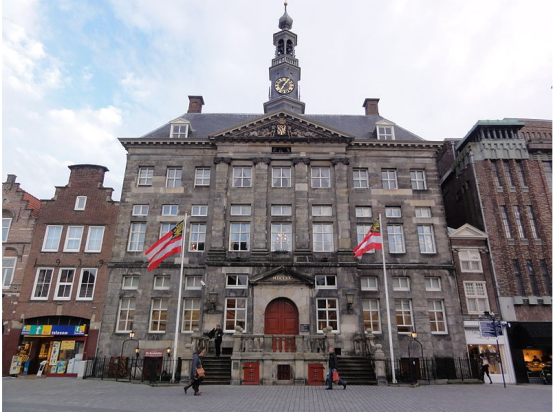
City Hall of 's-Hertogenbosch

Market square
The fortifications
's-Hertogenbosch has an extensive and almost complete fifteenth to seventeenth century city fortification. It was made to profit from the city's strong defensive position' laying on a sandy hill in the center of a large swamp fed by many rivers. This also caused that the main ramparts were preserved, because they were crucial in keeping out the water. In 2004 the city was awarded the title European Fortress City of the year. In the years that followed it restored many of the city defenses to much of their old glory.
Apart from small sections of medieval walls, the main structure of the fortification is a late medieval (fifteenth century) wall. The upper sections were removed when cannon became more powerful, and polygonal bastions were added, some after the conquest by the republic. Most of these have not been restored to their original height, but do maintain their brick walls. The citadel in the north west of the city does retain its original height. Around the city itself many other fortresses can still be seen.
In the north east of the old city, the hexagonal powder arsenal, or Kruithuis,[17] still exists, one of only two of its kind in the country. It is planned to become the museum of fortress 's-Hertogenbosch. One of the bastions of the fortress now houses the mini museum Bastionder. It has been dug out in a bastion of the south side. On the inside it shows a unique cannon, and an older bastion that was walled in by the current one.
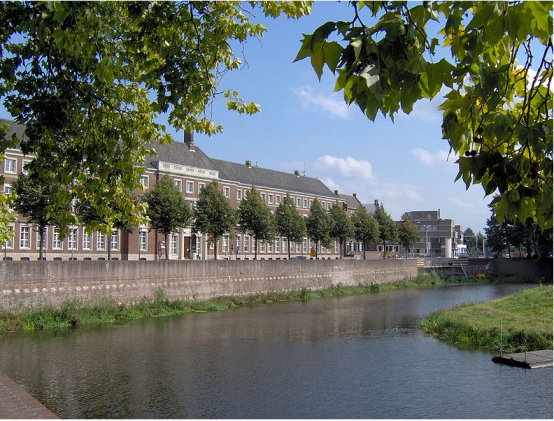
City rampart
Museums
The town's museums are the Stedelijk Museum 's-Hertogenbosch, the Noordbrabants Museum, the Jheronimus Bosch Art Center and the Museum Slager. The painter Hieronymus Bosch (c. 1450–1516) remains probably the best known citizen of 's-Hertogenbosch.
Nature
On the south side of the city, the city center and walls still border the Bossche Broek, an old polder that could never be made dry. In 1995 the dyke of the Dommel broke and an enormous amount of water entered the polder. It also flooded and blocked the main Dutch highway A2. In order to prevent this in the future, the area was rearranged to store access water in case of emergencies. In 2006 the area had been furnished with higher dikes and locks that allowed a controlled flooding of the polder and some adjacent areas.
The Bossche Broek is now a 202 ha nature reserve, that stretches all the way to Vught. It is connected to the Moerputten and Vlijmens Ven, with which it forms a Natura 2000 area. Rare species in the area are the Scarce large blue and the European weather loach, but what is really unique about the area is its proximity to a city center.
Miscellaneous
The city is also the location of the Bolwoningen complex, an array of fifty experimental spherical houses designed by Dries Kreijkamp.
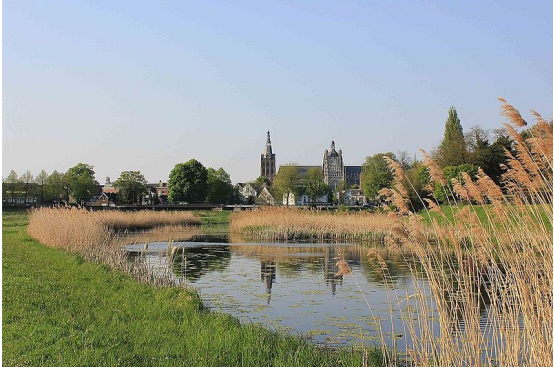
View on the St. Jan from Bossche Broek
六、历史文化
The city's official name is a contraction of the (archaic) Dutch des Hertogen bosch—"the Duke's forest". The duke in question was Henry I of Brabant, whose family had owned a large estate at nearby Orthen for at least four centuries. He founded a new town located on some forested dunes in the middle of a marsh. At age 26, he granted 's-Hertogenbosch city rights and the corresponding trade privileges in 1185. This is, however, the traditional date given by later chroniclers; the first mention in contemporaneous sources is 1196. The original charter has been lost. His reason for founding the city was to protect his own interests against encroachment from Gelre and Holland; from its first days, he conceived of the city as a fortress. It was destroyed in 1203 in a joint expedition of Gelre and Holland, but was soon rebuilt. Some remnants of the original city walls may still be seen.

In the late 14th century, a much larger wall was erected to protect the greatly expanded settled area. Artificial waterways were dug to serve as a city moat, through which the rivers Dommel and Aa were diverted. 's-Hertogenbosch became the birthplace and home of one of the greatest painters of the northern Renaissance period, Hieronymus Bosch, The town suffered a catastrophic fire in 1463, which the then (approximately) 13-year-old Bosch probably witnessed; presumably, this fire provided inspiration for the fiery hell-scapes that would later make Bosch famous.
Until 1520, the city flourished, becoming the second largest population centre in the territory of the present Netherlands, after Utrecht. The city was also a center of music, and composers, such as Jheronimus Clibano, received their training at its churches. Others held positions there: Matthaeus Pipelare was musical director at the Confraternity of Our Lady; and renowned Habsburg copyist and composer Pierre Alamire did much of his work at 's-Hertogenbosch.
Eighty Years' War
The wars of the Reformation changed the course of the city's history. It became an independent bishopric. During the Eighty Years' War, the city took the side of the Habsburg (Catholic) authorities and thwarted a Calvinist coup. It was besieged several times by Prince Maurice of Orange, stadtholder of most of the Dutch Republic, who wanted to bring 's-Hertogenbosch under the rule of the rebel United Provinces. The city was successfully defended by Claude de Berlaymont, also known as Haultpenne.
Thirty Years' War
In the years of Truce, before the renewed fighting after 1618, the fortifications were greatly expanded. The surrounding marshes made a siege of the conventional type impossible, and the fortress, deemed impregnable, was nicknamed the Marsh Dragon. The town was nevertheless finally conquered by Frederik Hendrik of Orange in 1629 in a typically Dutch stratagem: he diverted the rivers Dommel and Aa, created a polder by constructing a forty-kilometre dyke and then pumped out the water by mills. After a siege of three months, the city had to surrender—an enormous blow to Habsburg geo-political strategy during the Thirty Years' War. This surrender cut the town off from the rest of the duchy and the area was treated by the Republic as an occupation zone without political liberties (see also Generality Lands).
Louis XIV to Bonaparte
After the Peace of Westphalia, the fortifications were again expanded. In 1672, the Dutch rampjaar, the city held against the army of Louis XIV of France. In 1794 French revolutionary troops under the command of Charles Pichegru attacked the city. It was only weakly defended, and fell after a short siege. Pichegru then crossed the rivers and put an end to the Dutch Republic.
In the Batavian Republic, that was established in 1795, both Catholics and Brabanders at last gained equal rights. From 1806, the city became part of the Kingdom of Holland and from 1810, it was incorporated into the First French Empire. It was captured by the Prussians in 1814.
Kingdom of the Netherlands
The next year, 1815, when the United Kingdom of the Netherlands was established, it became the capital of North Brabant. Many newer and more modern fortresses were created in the vicinity of the city. A new canal was built, the 'Zuid-Willemsvaart', which gave the city an economic impulse. Trade, manufacturing and industry grew. Until 1878, it was forbidden to build outside the ramparts. That led to overcrowding and the highest infant mortality in the kingdom.
At the end of the 19th century, the very conservative city government prevented industrial investment to avoid an increase in the number of workers and the establishment of educational institutions: students were regarded as disorderly. As a result, the relative importance of the city diminished.
World War II and after
One of the few official Nazi concentration camp complexes in Western Europe outside Germany and Austria was named after 's-Hertogenbosch. It operated from January 1943, to September 1944 and was known to the Germans as Herzogenbusch (see List of subcamps of Herzogenbusch). About 30,000 inmates were interned in the complex during this time, of whom about 12,000 were Jews. In the Netherlands, this camp is known as 'Kamp Vught', because the concentration camp was actually located at a heath near Vught, a village a few kilometres south of 's-Hertogenbosch.
It was conquered by the Germans in World War II in 1940 and occupied by them for over four years. The allies struck back - the railway station was bombed by planes of the Royal Air Force on 16 September 1944. The city was liberated between 24–27 October 1944 during Operation Pheasant by British soldiers of Major-General Robert Knox Ross's 53rd (Welsh) Infantry Division after Major Donald Bremner of the 1st Battalion, East Lancashire Regiment, of 158th Infantry Brigade, had already routed the enemy on 23-24 October.
After the war, 's-Hertogenbosch was modernized, like many other cities in the Netherlands. It was probably only geography that shielded the old town from rigorous reconstruction in those early years. Just in time, the pendulum swung over to protecting the history of the city. In 1956, the council wanted to demolish the Moriaan, the oldest brick building in the Netherlands, to give traffic better access to the market square. The permit was refused by the government and instead the building was restored, starting in 1963. Later, city councils became much more aware of the value of historic buildings and from about the turn of the millennium, the historic fortifications are also given much attention by the authorities.
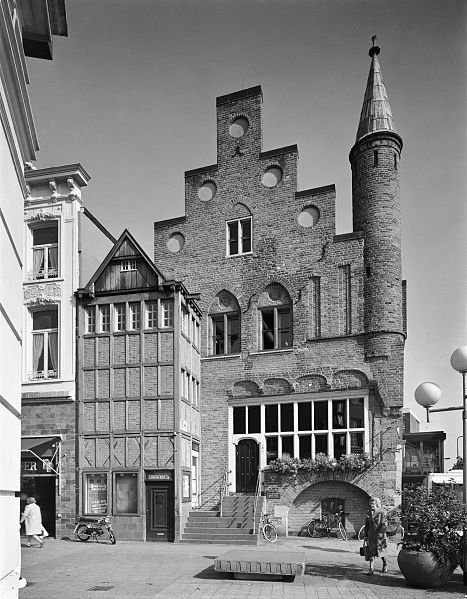
De Moriaan
七、其他信息
Culture
's-Hertogenbosch is home to a variety of events such as the theatre festival Boulevard, Jazz in Duketown, and hip hop in duketown, the start of the Tour de France (1996), Tour Feminin (1997), the International Vocal Competition, November Music (a contemporary music festival) and the UNICEF Open (formerly the Ordina Open) grass court tennis tournament (in the nearby town of Rosmalen). There are also over 350 restaurants, pubs and cafés to be found in the city.
's-Hertogenbosch is also home to the European Ceramic Work Centre. This is a juried international ceramic residency where they invite artists, designers and architects from around to the world to explore the medium of Ceramics. This program was initially started in 1991 and continues to this day.
The city has its own food speciality, the Bossche Bol—effectively a giant profiterole, somewhat larger than a tennis ball, which is filled with whipped cream and coated with chocolate.
The spoken language is Maaslands (The variant spoken in 's-Hertogenbosch is called Bosch which is placed among the Central North Brabantian dialects, although other classification systems also describe it as East Brabantian), which is very similar to colloquial Dutch.
De Toonzaal is a music venue for chamber music, improvised music, and experimental music. For popular music there is the venue W2 (or Willem II).
Carnival celebrations
's-Hertogenbosch has a strong carnival tradition. In its current form the story and symbolism dates from 1881-1883. In these years some citizens created the legend of "Oeteldonk", whereby the city was renamed to Oeteldonk for the three day carnival. "Donk" is a reference to a dry place in the marsh. The frog is widely used as a symbol during the 's-Hertogenbosch Carnival. It's also a symbol of the Oeteldonk Marsh.[14] It was also a remark aimed at Bishop Godschalk from Den Dungen, where 'Van den Oetelaar' was a common family name. He had wanted to forbid the traditional festivities of Shrove Tuesday that often led to excesses.
Oeteldonk is a village and therefore every inhabitant is a farmer or a girl. The village is headed by the Mayor of Oeteldonk "Peer vaan den Muggenheuvel tot den Bobberd". Each year the mayor of 's-Hertogenbosch hands over his authority to the Mayor of Oeteldonk. On Sunday at 11:11 AM the Mayor of Oeteldonk then receives Prince Carnaval "Prince Amadeiro XXV" at Oeteldonk central station. From there a parade of all carnival clubs escorts the company to the town hall.
The citizens of 's-Hertogenbosch wear traditional outfits throughout these days. A so-called boerenkiel is worn and every year patches are designed according to that years theme which can then be stitched onto the outfit. The boerenkiel is often combined with a traditional farmers bandana and a long scarf in the colors of Oeteldonk. The tradition of the Boerenkiel and / or Bandana is very different from the carnival traditions in the rest of the Netherlands. Other aspects like the parade, the temporary name and the temporary flag (for Oeteldonk red - white - and - yellow) are very similar.
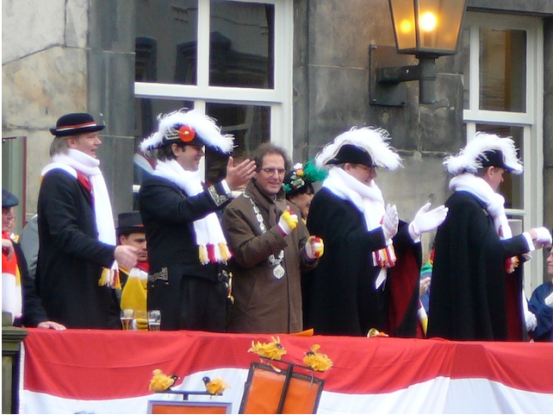
Mayor Ton Rombouts, the Mayor of Oeteldonk, and the prince at City Hall in 2007
八、联系方式
Mayor: Jack Mikkers (VVD)
telephone number (073) 206 88 88 or 0800 35 000 12 (temporarily free)
Whatsapp 073 206 88 88 (via the app on the mobile phone)
Twitter:'s-Hertogenbosch@shertogenbosch
Facebook: Gemeente 's-Hertogenbosch@Gemeente.shertogenbosch
WhatsApp +31 73 615 5155
Municipality of ‘s-Hertogenbosch
Wolvenhoek 1, 5211 HH ’s-Hertogenbosch, The Netherlands
https://www.s-hertogenbosch.nl/
https://www.kijkopkoo.nl/
